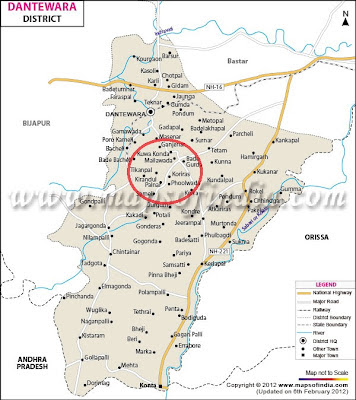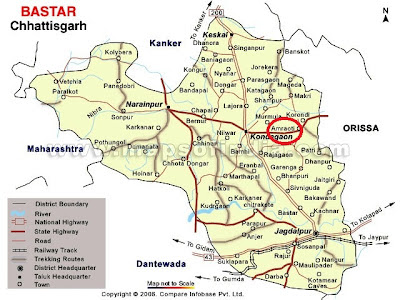Kailash Cave
(A blog by Jitendra Nakka)
Introduction
Bastar, being a plateau region, serves as the home
of some of the most incredibly beautiful valleys namely Bastarnaar Valley,
Darbha valley, Keshkaal valley e.t.c. Among these, one of the most beautiful valleys
is Kanger Valley National Park. This park is one of the most awaited projects
of state of Chhattisgarh, as the Govt. has given a proposal to Central Govt. to
make this site as a “Bio-Diversity Heritage site”. It is not just because here
we have some of the rarest species of flora and fauna, but because, here we
have some of the most exotic natural caves. Although forest department and
local people have found more than a half dozen of caves, but for general
tourist, only three caves are opened for the sake of security of people. Forest
department admits its responsibility to open other caves soon. These three
caves are Dandak Cave, Kutumsar Cave, Kailash Cave. Next to Kutumsar Cave, the
most desirable cave is Kailash Gufa(means
cave).
Figure showing Stalactites
Where and how to reach?
Kailash Cave is reachable from two ways. The first
one is NH-16(Jagdalpur-Hyderabad Highway).
Just after 28km on NH-16, there is a check-post of Forest department for the
entrance of Kanger Valley National Park. After paying nominal charges, one can
enter this National Park. After some distance, we can get one guest house of
Kanger valley National park. From there, just after travelling 3kms to the way
of famous Kutumsar caves, to the left of it, there lies a 12km long road which
directly takes us to Koleng forest range no.75. There lies a series of small
hills. Among one of this hill, there lies the beautiful Kailash Cave.
Fig: Way to Kailash Caves (last 6 kilometers)
The second way or the alternate way is the route
from Jagdalpur to Netanaar via Sargipaal, Jaatam, Nangur, kawaali, e.t.c. Right
at the entrance barrier of kailash caves (which
is around 5km away from the cave) ,
we can see one rest house where we can lose our fatigue for a while. Even below
the hill where cave is located, we have the facility of rest and water. But as
Jagdalpur is the nearest city, you have to get your food and other accessories
from Jagdalpur itself.
Fig: Way to Kailash Caves (last 6 kilometers)
Salient Features:
Kailash Cave came into light from 1993, whereas the
people say that the local villagers came to know about it very earlier. The
actual credit for revealing this cave goes to Forest guard – Sonsay, Rajaram
Shivhare, watchman Sitaram, Gang-Superviser Jhaduram Yadav and Range officer
Roshan Lal Sahu. Due to dusk, they missed to see it on 18 March 1993, but
later, they came again on the site on 22 March, and found this marvel. As they
went inside, they got fantasized by a entire world of conical karst structures,
and seeing some of the structures as Shivling, they named it as “Kailash Gufa(means cave)”.
Figure showing the entrance mouth of Kailash Cave
From land surface, Kailash cave is formed nearly 40m
above towards the hill. Uptill now, the known length of the cave is nearly
1000ft and the depth of the cave is 120ft. Bending down and entering to a
narrow entrance, you can see some stairs made by forest department, for the
ease of tourists. Just after entering inside, in the very beginning, before stepping
down, I noticed development of some very young buds of stalactites.
Just after entering 100ft down, we can start seeing budding
structures of Stalactites and Stalagmites.
Figure showing stalactites and stalagmites
These Stalactites and Stalagmites are generally
formed in caverns(a geological term used
for caves). As water drips from the roof of a cavern, evaporation leaves a
small deposit of Calcium Carbonate (Calcite)
behind. Gradually a cone shaped pillar of calcium-carbonate, hanging from the
cavern roof develops. Such a deposit is called “stalactite”. Similar deposit
also grows from the floors of the caverns where the limewater drops. Such
inverted conical-pillar like structure is called “stalagmite”. When a
stalactite and a stalagmite meet, a “column” is formed called “dripstone”.
Figure showing Stalagmites
If you can
see some broken pieces of a stalactite, you can observe that sometimes in the
cavities of rocks, the ground water deposits crystals of quartz, calcite or
other minerals. This respective deposit is called “Geode” and structure is
called Geode structure.
Going few meters ahead, we can observe the change in
shape and size of the cavern as the chamber turns into 25 ft wide and 35 ft
long hall, where one can observe greater colonies of budding and developed
structures of stalactites and stalagmites.
Figure showing Stalagmites
Just after few meters, it seems like we have came to
final chamber, which can be assumed to be 135ft long, 100ft wide and 25ft high.
For a tourist coming such a place for the first time, seems like lost yourself
in the world of fantasy….a complete new world…something like a dream which came
true. The whitish conical structures
play such a magic that nobody can save himself, from getting lost in this dream
world.
Conclusion:
After coming out, people share their experience
shouting, screaming, cherishing. Some people may call those conical structures
as “Jhumar”, some people may call those dripstones as “elephant nose”, and some
may call it as “Bhim ki Gada”. Numerous reactions, but only one wish,-“ I just
love it…If ever I’ll get a chance, I’ll come back here again and again.
For the promotion of this valley, Forest
department has made watch tower nearby this cave in order to enjoy the broad
view of the valley side. Nearby one lake-like reservoir is there, which is
called as “Kailash Lake”. Adding to the beauty of this valley, Bhainsa-Darha Crocodile
Lake is also worth-seeing site.
Note:
A part of this citation has been inspired by Dr. Suresh Tiwari’s book- “Bastar-
Paryatan, Itihaas aur Sanskriti “




























.JPG)
.JPG)

























